Section 4: Family violence against seniors
By Maire Sinha and Shelly Milligan
- Prevalence of police-reported violence against seniors
- Risk factors for violence against seniors
- Severity of violence against seniors
- Motives in homicides against seniors
- Clearance rates
- Trends and regional patterns in violence against seniors
- Summary
- Detailed data tables
- References
- Notes
Family violence can occur across the entire lifespan, including into the older years of adulthood (Walsh et al. 2007). Violence against seniors may be a continuation of family violence into the older years, as in some cases of spousal victimization, or alternatively, violence may first begin during the senior years. Like all types of violent crime, this violence exists within the larger socio-demographic framework of Canadian society. Any major shifts in this framework, such as changes in the size and composition of the senior population, can impact the prevalence and nature of family violence against seniors (Chappell et al. 2003). Indeed, the current population of seniors is undergoing notable changes.
Persons aged 65 years and older now represent a growing segment of the Canadian population, from 9% in 1981 to 14% of the population in 2009 (Statistics Canada 2010).Note 1 The impact of this population growth on the prevalence of family violence against seniors is complex when considering the heterogeneity of the senior population.
Population health research suggests that seniors are generally healthier, more active, and more financially secure than in the past (Turcotte and Schellenberg 2007). In fact, seniors score higher than their younger counterparts on a number of indicators of both mental and physical health, particularly perceived well-being and psychological stress (Turcotte and Schellenberg 2007). Indicators of financial security for seniors have also improved, namely a decline in low income among seniors, a growth in assets, and an increase in home ownership (Turcotte and Schellenberg 2007). These factors suggest that the current population of seniors are less dependent on others than previous generations (Chappell et al. 2003).
While the growing majority of seniors require little outside assistance (Chappell et al. 2003), longer life expectancy of seniors means that the proportion of the oldest seniors has grown. These seniors are more likely than younger seniors to suffer from physical or cognitive impairments, which often necessitate either informal sources of support from family members or formal social support services (Bravell et al. 2008). Seniors with disabilities may be especially vulnerable to victimization at the hands of caregivers, as previous research has found that individuals, including older adults, with disabilities are generally more at risk of victimization than able bodied persons (Brennan 2012; Perreault 2009).
This section profiles family violence against seniors, namely those aged 65 years and older, to better understand the unique nature of this violence among the diverse population of seniors in Canada. To this end, police-reported data are used to examine the prevalence, risk factors, severity, motivations, police charging, regional variations and trends in family violence against seniors. These characteristics are contrasted against violence against seniors not involving family members. Included in the comparative analysis of family and non-family violence are all violent Criminal Code incidents against seniors substantiated by police. Not included are those incidents that are not Criminal Code offences, such as emotional abuse, as well as non-violent incidents, such as theft or fraud.
Prevalence of police-reported violence against seniors
Rates of family violence lowest among senior Canadians
Canadians' risk of being the victim of a violent crime generally decreases with age. As a reflection of this overall pattern, seniors had the lowest rates of police-reported violent crime, regardless of whether this violence was perpetrated by a family member or someone outside the family network. In 2010, there were 61 senior victims of family violence per 100,000 population, totalling nearly 2,800 senior victims of police-reported violence. This rate of family violence was about 7.5 times lower than that of the most at-risk age group of 25-to-34 year olds, and half the rate of the second oldest age cohort of 55-to-64 year olds (Chart 4.1).
Chart 4.1
Victims of police-reported violent crime, by family and non-family members and age group of victim, Canada, 2010
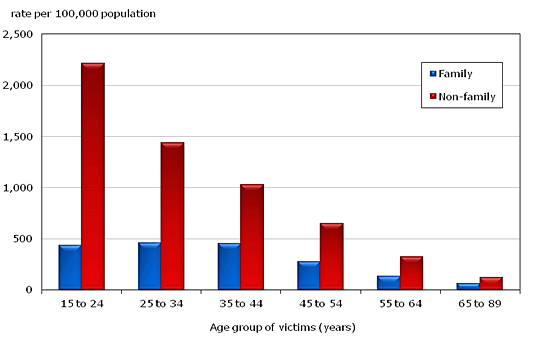
Note: Family violence refers to violence committed by spouses, children, siblings, and extended family. Spouses include victims aged 15 to 89 years. All other family relationships include victims aged 0 to 89 years. Non-family violence refers to violence committed by friends, casual acquaintances, dating partners, business associates, criminal associates, authority figures, and strangers. Excludes incidents where the victim's sex and/or age was unknown. Rates are calculated on the basis of 100,000 population. Populations based upon July 1st estimates from Statistics Canada, Demography Division.
Source: Statistics Canada, Canadian Centre for Justice Statistics, Incident-based Uniform Crime Reporting Survey.
One possible explanation for the reduced likelihood of family violence among seniors relates to seniors' lower levels of exposure to potential perpetrators compared to their younger counterparts. According to the 2006 Census, a greater proportion of seniors than non-senior adults between the ages of 18 and 64 years lived alone, rather than with family members (28% versus 11%). Further, seniors who live healthy and independent lives often do not require the assistance from grown children (Chappell et al. 2003). Also, in some cases, particularly among senior women, seniors outlive their spouses and are therefore not at risk of spousal violence (Chappell et al. 2003).
In 2010, seniors' risk of family violence was lower than their risk of violence committed by a friend or acquaintance, but higher than their risk of stranger-perpetrated violence (Table 4.1). Altogether, the rate of family violence against seniors was half that of non-family violence (61 per 100,000 versus 124 per 100,000).
As discussed in Section 1, some academic and research communities have considered the inclusion of all forms of intimate partner violence, namely spousal and dating violence, within a definition of family violence. Based on 2010 police-reported data, incorporating dating violence within the category of family violence would have a negligible impact on the prevalence of family violence against seniors. That is, the rate of family violence against seniors including dating violence would be only slightly higher than a rate exclusive of dating violence (65 victims per 100,000 population versus 61 victims per 100,000 population).
Risk factors for violence against seniorsNote 2
Senior women more at risk of family violence than senior men
As with patterns for police-reported violence against younger adults, gender differences in risk of victimization depend on whether the violence occurs within or outside the family network. In 2010, senior women were more vulnerable to family violence, with rates 34% higher than those of senior men. Conversely, senior men's rate of non-family violence was almost double that for senior women (166 versus 90 per 100,000).
The heightened risk of family violence among women can be largely explained by senior women's higher prevalence of spousal violence compared to senior men (Table 4.1, Chart 4.2). Specifically, in 2010, the rate of spousal violence for senior women was more than double the rate for senior men (22 versus 10 per 100,000 population). Senior women were also slightly more likely than senior men to be victimized by their children in 2010 (27 per 100,000 versus 24 per 100,000 population).
Chart 4.2
Senior victims of police-reported violent crime by family members, by sex of victim and accused-victim relationship, Canada, 2010
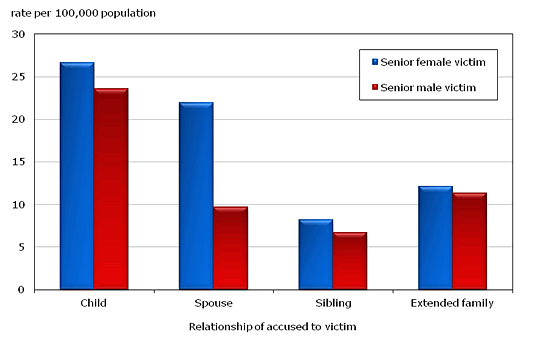
Note: Excludes incidents where the victim's sex and/or age was unknown. Rates are calculated on the basis of 100,000 population of seniors aged 65 to 89. Populations based upon July 1st estimates from Statistics Canada, Demography Division.
Source: Statistics Canada, Canadian Centre for Justice Statistics, Incident-based Uniform Crime Reporting Survey.
For both sexes, grown children were the most common perpetrators of family violence (39% of women and 46% of men). This was particularly the case when the violence escalated in the killing of seniors. Over the past decade, half (50%) of all family homicides against seniors were committed by grown children.
Younger seniors more vulnerable to violent crime than older seniors
Age is an important factor associated with seniors' vulnerability to both family and non-family violence. Historically, younger seniors have been more at risk of violence than older seniors by both their family members and other types of perpetrators (Sinha 2011; Ogrodnik 2007). Data from 2010 confirm these earlier findings for both family and non-family violence against seniors. In particular, age-specific rates of family violence against seniors peak at age 65 and then generally decline (Chart 4.3).
Chart 4.3
Senior victims of police-reported violent crime by family members, by age of victim, Canada, 2010
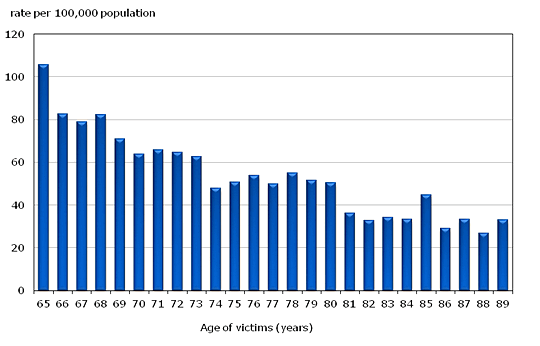
Note: Family violence refers to violence committed by spouses, children, siblings, and extended family. Excludes incidents where the victim's sex and/or age was unknown. Rates are calculated on the basis of 100,000 population of seniors aged 65 to 89. Populations based upon July 1st estimates from Statistics Canada, Demography Division.
Source: Statistics Canada, Canadian Centre for Justice Statistics, Incident-based Crime Reporting Survey.
The type of perpetrator responsible for violence against seniors is also closely connected to the age of seniors. Seniors in their mid-to-late 70s were more likely to be victimized by their family members, particularly grown children (Chart 4.4). The same cannot be said for all seniors, however, as seniors were most often victimized by friends and acquaintances when they were in their 60s and early 70s, as well as when they were over the age of 80.
Chart 4.4
Senior victims of police-reported violent crime, by age group of victim and accused-victim relationship, Canada, 2010
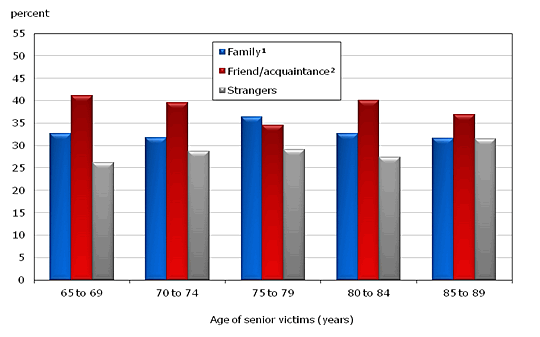
1. Family refers to spouses, children, siblings, and extended family.
2. Friend/acquaintance refers to friends, casual acquaintances, dating partners, business associates, criminal associates, and neighbours.
Source: Statistics Canada, Canadian Centre for Justice Statistics, Incident-based Crime Reporting Survey.
Among incidents of family violence, the representation of grown children as accused family members increases as seniors age, perhaps reflecting seniors' increasing levels of dependence and the growing likelihood of being widowed. In 2010, 36% of family perpetrators against seniors aged 65 to 69 years were grown children, followed by spouses at 30%. By age 85 to 89 years, grown children accounted for nearly half (49%) of all family perpetrators, while spouses represented 21% of family perpetrators.
Severity of violence against seniors
Common assault most frequent form of family violence against seniors
Offence type, use of weapons, and prevalence of injuries can be indicators of the severity of violent crime. According to police-reported data, the types of criminal offences committed against senior victims of family and non-family violence differ in important ways. In 2010, physical assaults occurred more frequently in family violence incidents against seniors compared to non-family violence incidents (67% versus 45%) (Table 4.2). Common assault, the least serious form of assaults, accounted for the majority of these violations.
Physical assaults were more common in spousal violence than other forms of family violence against seniors. In 2010, police-reported physical assaults accounted for 81% of incidents committed by spouses, higher than the proportion involving grown children (66%), accused siblings (64%) and extended family members (53%).
One offence almost exclusively committed by non-family members was robbery. This offence accounted for 13% of non-family violence incidents against seniors. In comparison, 1% of family violence incidents involved robbery. For the most serious crimes of homicide, there was no difference between the proportions committed by family and non-family members.
Family violence against seniors more likely than non-family violence to involve the use of physical force
As with violent crime in general, the majority of violence perpetrated against seniors does not involve the use of weapons. This was the case for both family and non-family violence (Table 4.3). More specifically, in 2010, weapons were used against 14% of senior victims of family violence and 16% of victims of non-family violence. Despite the similarity in the overall prevalence of weapon use, when a weapon was used, firearms were less commonly used by family members than non-family members (6% versus 17%) against the senior victim. This can be partly explained by the higher volume of robbery offences among incidents of non-family violence against seniors, as the commission of robbery offences more often than other violent offences involves the presence of a firearm (35% of non-family violence incidents).
Physical force was used to a greater degree by accused family members than other perpetrators. This was particularly evident when the victim was a spouse or parent. In 2010, 61% of family violence incidents against seniors involved the use of physical force, compared to 50% of non-family violence incidents. Gender differences in the use of physical force were virtually non-existent for both family and non-family violence against seniors.
Senior victims of family violence more likely than other senior victims to sustain injuries
Accused family members' greater use of physical force translates into a higher frequency of injuries among senior victims of family violence. In 2010, 39% of senior victims of family violence sustained injuries as a result of the violent crime, while the same was true for 30% of non-family violence victims (Table 4.4). Minor treatment, such as first aid, as opposed to professional medical intervention, was required for most of these injuries (93% of family violence and 91% of non-family violence incidents). While there were no notable gender differences in the occurrence of injuries for incidents of family violence (40% of males and 39% of females), male victims of non-family violence were more likely than female victims to sustain injuries (34% versus 24%).
There were some differences in the likelihood of injuries depending on the victim and accused familial relationship. Injuries were most common among senior victims of spousal violence (48%), followed by victims of violence from grown children (39%), siblings (37%) and extended family members (30%). These patterns can be attributed to the higher volume of physical assaults and lower volume of uttering threat offences directed at spousal victims compared to other family violence victims.
Motives in homicides against seniors
Using data from the Homicide Survey, it is possible to examine the motivating factors underlying homicides against seniors. Over the previous decade, there were salient differences in the motives of accused family members and other perpetrators. Frustration and the escalation of an argument were the two most common motivating factors in family homicides against seniors, each accounting for at least one-quarter of family homicides (32% and 26%) (Table 4.5).
In comparison, financial gain was the leading motive in non-family homicides of seniors (30%). This can be largely attributed to the fact that one in four senior victims (25%) of non-family homicide was killed during the commission of a robbery. A similar proportion of family and non-family homicides against seniors were committed without any apparent motive (20% and 19%).
Clearance rates
Family violence against seniors more likely than other violence against seniors to result in charges
There are a number of ways police may discover that a senior has been or is being victimized. Seniors may report the violence themselves, while at other times violence may be reported by another individual, including witnesses, family members and professionals. In some provinces, reporting suspected abuse of seniors is mandated through adult protection legislation, which compels professionals working with seniors to report cases of suspected abuse (AuCoin 2003). Still, some proportion of violence against seniors will never come to the attention of police. Underreporting may be particularly pronounced in cases where seniors are isolated and levels of detection are consequently lower (Teaster et al. 2006; Grama 2000).
When family violence against seniors does come to the attention of police, it is more likely than other forms of violence against seniors to result in charges being laid or recommended. Just over-half (51%) of incidents of family violence resulted in a charge, higher than the 31% charge rate for non-family violence incidents against seniors (Table 4.6). Family violence incidents were also slightly more likely to be cleared by other means (33% versus 29%), such as the senior victim declining to lay charges and departmental discretion.
Trends and regional patterns in violence against seniors
Family homicides against seniors decrease
As previously mentioned, family violence against seniors may never reach the attention of police (Sev'er 2009). Based on results from the 2009 General Social Survey,Note 3 just under half (46%) of all violent incidents against older adults, aged 55 and older, were reported to police (Brennan 2012). Issues of reporting, however, are non-existent when the violence culminates in the death of the victim (Nivette 2011; Gannon et al. 2005). Consequently, any shifts in the homicide rate of seniors can be taken as a strong indicator of overall trends in violence against seniors.
Despite annual fluctuations, rates of family homicide against seniors have been relatively stable over the past fifteen years (Chart 4.5). In the past, rates of family homicides against seniors have been generally lower than rates of non-family homicide. However, the more steady and sharp declines in non-family homicides against seniors, particularly during the 1980s, compared to family homicide have resulted in rates of family and non-family homicide against seniors that are at near parity in recent years.
Chart 4.5
Senior victims of homicide, by family and non-family members, Canada, 1980 to 2010
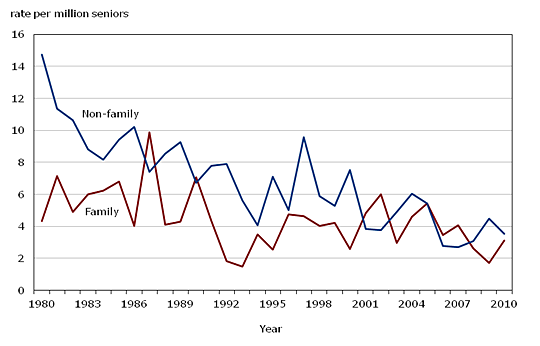
Note: Family homicide refers to homicide committed by spouses, children, siblings, and extended family. Non-family homicide refers to homicide committed by friends, casual acquaintances, dating partners, business associates, criminal associates, authority figures, and strangers. Excludes homicides where the age and/or sex of the victim was unknown. Rates are calculated on the basis of 1,000,000 seniors aged 65 years and older. Populations based upon July 1st estimates from Statistics Canada, Demography Division.
Source: Statistics Canada, Canadian Centre for Justice Statistics, Homicide Survey.
Rates of family violence against seniors highest in western provinces
Provincial and territorial rates of family violence against seniors tend to vary in the same way as overall violent crime rates. In particular, in 2010, seniors living in the territories had a higher risk of family violence than seniors residing in the provinces (Table 4.7). Nunavut also differed from the provinces, as well as the other territories, in that the rate of family violence against seniors was higher than that of non-family violence (2,312 versus 905 per 100,000 population).
At the provincial level, western provinces consistently recorded the highest rates of family violence against seniors, without exception. In the same vein, rates of non-family violence against seniors were highest in British Columbia, Manitoba, and Saskatchewan. However, the rate of non-family violence in Alberta was below those of New Brunswick, Nova Scotia and Quebec.
Along with provincial variations in overall prevalence of violence against seniors, gender differences in family violence against seniors varied in some provinces and territories (Table 4.7). That is, senior women's elevated risk of family violence was not evident in all provinces. Senior men living in Newfoundland and Labrador and Prince Edward Island were more likely than senior women to be a victim of family violence.
Family violence against seniors lower in census metropolitan areas
There may be a perception that the cities or census metropolitan areas (CMAs),Note 4 have higher rates of violent crime than non-CMAs. This was not the case for violence against seniors, particularly for family violence against seniors. The likelihood of seniors being a victim of family violence was lower among those living in a CMA and highest among those seniors residing in non-CMA areas (51 versus 79 per 100,000 seniors) (Table 4.8).
Some of the smaller CMAs were among those with the highest rates of family violence against seniors. Abbotsford-Mission recorded the highest rate of family violence against seniors (103 per 100,000), followed by Regina (85), and Peterborough (74). Apart from Peterborough, all CMAs had rates of family violence lower than rates of non-family violence.
Summary
In keeping with findings from previous years, seniors had the lowest risk of police-reported violent crime in 2010. While both the age and sex of seniors impacted this risk, seniors were generally more likely to be a victim of non-family violence than family violence. However, violence against seniors was sometimes more severe when the perpetrator was a family member, as senior victims of family violence were more likely than other senior victims to be physically assaulted and, consequently, they were also more frequently injured.
Regional variations in family and non-family violence against seniors followed similar patterns. Provincial rates of family and non-family violence against seniors were generally highest in the west and lowest in the east. Non-census metropolitan areas of Canada had higher rates of family violence against seniors compared to census metropolitan areas.
Detailed data tables
References
AuCoin, K. 2003. "Family violence against older adults." H. Johnson and K. AuCoin (eds.) Family Violence in Canada: A Statistical Profile. Statistics Canada Catalogue no. 85-224-X.
Bravell, M. E., S. Berg and B. Malmberg. 2008. "Health, functional capacity, formal care, and survival in the oldest old: A longitudinal study." Archives of Gerontology and Geriatrics. Vol. 46, p. 1-14.
Brennan, S. 2012. "Victimization of older Canadians, 2009." Juristat. Statistics Canada Catalogue no. 85-002-X.
Chappell, N. Gee, E. McDonald, L. and Stones, M. 2003. Aging in Contemporary Canada. Toronto. Prentice Hall.
Gannon, M., K. Mihorean, K. Beattie, A. Taylor-Butts and R. Kong, 2005. Criminal Justice Indicators. Statistics Canada Catalogue no. 85-227-X.
Grama, J.I. 2000. "Women forgotten: Difficulties faced by rural victims of domestic violence." American Journal of Family Law. Vol. 14. p. 173-189.
Nivette, A. 2011. "Cross-national predictors of crime: a meta-analysis." Homicide Studies. Sage Publications. Vol. 15, no. 2. p. 103-131.
Ogrodnik, L. 2007. "Seniors as victims of crime." Canadian Centre for Justice Statistics Profile Series. Statistics Canada Catalogue no. 85F0033M. No. 14.
Perreault, S. 2009. "Criminal victimization and health: A profile of victimization among persons with activity limitations or other health problems." Canadian Centre for Justice Statistics Profile Series. Statistics Canada Catalogue no. 85F0033X. No. 21.
Sev'er, A. 2009. "More than wife abuse that has gone old: A conceptual model for violence against the aged in Canada and the US." Journal of Comparative Family Studies. Spring. Vol. 40, no. 2. p.279-292.
Sinha, M. 2011. "Police-reported family violence against seniors, 2009." Family Violence in Canada: A Statistical Profile. Statistics Canada Catalogue no. 85-224-X.
Statistics Canada. 2006. Census – Household Living Arrangements. Statistics Canada Catalogue no. 97-553-X.
Statistics Canada. 2010. Population Projections for Canada, Provinces and Territories 2009 to 2036. Statistics Canada Catalogue no. 91-520-X.
Teaster, P, K.A. Roberto and T.A. Dugar. 2006. "Intimate partner violence of rural aging women." Family Relations. Vol. 55. p. 636-648.
Turcotte M. and G. Schellenberg. 2007. A Portrait of Seniors in Canada. Statistics Canada Catalogue no. 89-519-X.
Walsh, C.A., Ploeg, J., Lohfeld, L., Horne, J., Macmillan, H. and Lai, D. 2007. "Violence across the lifespan: Interconnections among forms of abuse as described by marginalized Canadian elders and their care-givers." British Journal of Social Work. Vol. 37, no.3. p. 491-514.
Notes
- The leading contributors to this growth include the ageing baby boomer population, the decrease in fertility rates and the increase in life expectancies (Turcotte and Schellenberg 2007).
- The following sections examine the characteristics of family violence according to the definition of family violence exclusive of dating violence.
- The General Social Survey on Victimization is a household survey conducted every five years that asks Canadians about their experiences of victimization. Data from the Northwest Territories, Yukon and Nunavut were collected using a different methodology and are therefore excluded. For further details, see Section 1 and the Data sources section.
- A census metropolitan area (CMA) consists of one or more neighbouring municipalities situated around a major urban core. A CMA must have a total population of at 100,000 of which 50,000 or more live in the urban core. To be included in the CMA, other adjacent municipalities must have a high degree of integration with the central urban area, as measured by commuting flows derived from census data. A CMA typically comprises more than one police service.
- Date modified: